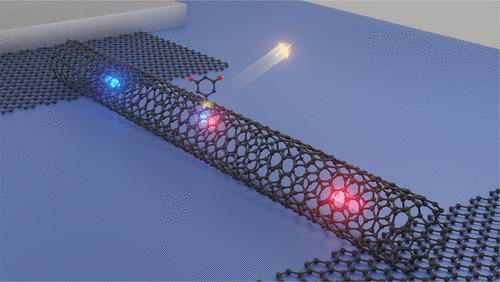Our official English website, www.x-mol.net, welcomes your
feedback! (Note: you will need to create a separate account there.)
Electroluminescence from Single-Walled Carbon Nanotubes with Quantum Defects
ACS Nano ( IF 15.8 ) Pub Date : 2022-06-22 , DOI: 10.1021/acsnano.2c03083 Min-Ken Li 1, 2 , Adnan Riaz 2, 3 , Martina Wederhake 4 , Karin Fink 3 , Avishek Saha 5 , Simone Dehm 3 , Xiaowei He 5 , Friedrich Schöppler 4 , Manfred M Kappes 1, 3, 6 , Han Htoon 5 , Valentin N Popov 7 , Stephen K Doorn 5 , Tobias Hertel 4 , Frank Hennrich 1 , Ralph Krupke 1, 2, 3
ACS Nano ( IF 15.8 ) Pub Date : 2022-06-22 , DOI: 10.1021/acsnano.2c03083 Min-Ken Li 1, 2 , Adnan Riaz 2, 3 , Martina Wederhake 4 , Karin Fink 3 , Avishek Saha 5 , Simone Dehm 3 , Xiaowei He 5 , Friedrich Schöppler 4 , Manfred M Kappes 1, 3, 6 , Han Htoon 5 , Valentin N Popov 7 , Stephen K Doorn 5 , Tobias Hertel 4 , Frank Hennrich 1 , Ralph Krupke 1, 2, 3
Affiliation

|
Individual single-walled carbon nanotubes with covalent sidewall defects have emerged as a class of photon sources whose photoluminescence spectra can be tailored by the carbon nanotube chirality and the attached functional group/molecule. Here we present electroluminescence spectroscopy data from single-tube devices based on (7, 5) carbon nanotubes, functionalized with dichlorobenzene molecules, and wired to graphene electrodes. We observe electrically generated, defect-induced emissions that are controllable by electrostatic gating and strongly red-shifted compared to emissions from pristine nanotubes. The defect-induced emissions are assigned to excitonic and trionic recombination processes by correlating electroluminescence excitation maps with electrical transport and photoluminescence data. At cryogenic conditions, additional gate-dependent emission lines appear, which are assigned to phonon-assisted hot-exciton electroluminescence from quasi-levels. Similar results were obtained with functionalized (6, 5) nanotubes. We also compare functionalized (7, 5) electroluminescence data with photoluminescence of pristine and functionalized (7, 5) nanotubes redox-doped using gold(III) chloride solution. This work shows that electroluminescence excitation is selective toward neutral defect-state configurations with the lowest transition energy, which in combination with gate-control over neutral versus charged defect-state emission leads to high spectral purity.
中文翻译:

具有量子缺陷的单壁碳纳米管的电致发光
具有共价侧壁缺陷的单个单壁碳纳米管已成为一类光子源,其光致发光光谱可以通过碳纳米管的手性和附着的官能团/分子来定制。在这里,我们展示了基于 (7, 5) 碳纳米管、用二氯苯分子功能化并连接到石墨烯电极的单管器件的电致发光光谱数据。我们观察到电产生的、缺陷引起的发射,这些发射可通过静电门控控制,并且与原始纳米管的发射相比强烈红移。通过将电致发光激发图与电传输和光致发光数据相关联,将缺陷引起的发射分配给激子和三离子复合过程。在低温条件下,出现额外的门相关发射线,这些发射线被分配给来自准能级的声子辅助热激子电致发光。用功能化的 (6, 5) 纳米管获得了类似的结果。我们还将功能化 (7, 5) 电致发光数据与使用金 (III) 氯化物溶液氧化还原掺杂的原始和功能化 (7, 5) 纳米管的光致发光进行比较。这项工作表明,电致发光激发对具有最低跃迁能量的中性缺陷态配置具有选择性,这与对中性与带电缺陷态发射的栅极控制相结合可导致高光谱纯度。我们还将功能化 (7, 5) 电致发光数据与使用金 (III) 氯化物溶液氧化还原掺杂的原始和功能化 (7, 5) 纳米管的光致发光进行比较。这项工作表明,电致发光激发对具有最低跃迁能量的中性缺陷态配置具有选择性,这与对中性与带电缺陷态发射的栅极控制相结合可导致高光谱纯度。我们还将功能化 (7, 5) 电致发光数据与使用金 (III) 氯化物溶液氧化还原掺杂的原始和功能化 (7, 5) 纳米管的光致发光进行比较。这项工作表明,电致发光激发对具有最低跃迁能量的中性缺陷态配置具有选择性,这与对中性与带电缺陷态发射的栅极控制相结合可导致高光谱纯度。
更新日期:2022-06-22
中文翻译:

具有量子缺陷的单壁碳纳米管的电致发光
具有共价侧壁缺陷的单个单壁碳纳米管已成为一类光子源,其光致发光光谱可以通过碳纳米管的手性和附着的官能团/分子来定制。在这里,我们展示了基于 (7, 5) 碳纳米管、用二氯苯分子功能化并连接到石墨烯电极的单管器件的电致发光光谱数据。我们观察到电产生的、缺陷引起的发射,这些发射可通过静电门控控制,并且与原始纳米管的发射相比强烈红移。通过将电致发光激发图与电传输和光致发光数据相关联,将缺陷引起的发射分配给激子和三离子复合过程。在低温条件下,出现额外的门相关发射线,这些发射线被分配给来自准能级的声子辅助热激子电致发光。用功能化的 (6, 5) 纳米管获得了类似的结果。我们还将功能化 (7, 5) 电致发光数据与使用金 (III) 氯化物溶液氧化还原掺杂的原始和功能化 (7, 5) 纳米管的光致发光进行比较。这项工作表明,电致发光激发对具有最低跃迁能量的中性缺陷态配置具有选择性,这与对中性与带电缺陷态发射的栅极控制相结合可导致高光谱纯度。我们还将功能化 (7, 5) 电致发光数据与使用金 (III) 氯化物溶液氧化还原掺杂的原始和功能化 (7, 5) 纳米管的光致发光进行比较。这项工作表明,电致发光激发对具有最低跃迁能量的中性缺陷态配置具有选择性,这与对中性与带电缺陷态发射的栅极控制相结合可导致高光谱纯度。我们还将功能化 (7, 5) 电致发光数据与使用金 (III) 氯化物溶液氧化还原掺杂的原始和功能化 (7, 5) 纳米管的光致发光进行比较。这项工作表明,电致发光激发对具有最低跃迁能量的中性缺陷态配置具有选择性,这与对中性与带电缺陷态发射的栅极控制相结合可导致高光谱纯度。











































 京公网安备 11010802027423号
京公网安备 11010802027423号